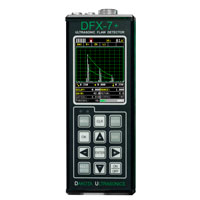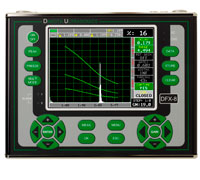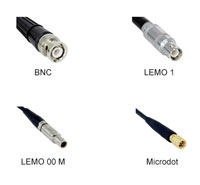
Flaw Detectors
Ultrasonic flaw detectors are designed to detect, size, position, and differentiate between flaw types in various materials and welded joints. A flaw detector must be fast, in terms of its sample and screen refresh rate, as inspectors are generally scanning the surface of a part or test specimen at a relatively high speed, rather than looking for the thickness at a specific point or location. While flaw detectors can also measure the material thickness with reasonable accuracy, they are not designed with precision thickness as their primary focus. Our DFX models combine the two types of gauges into one powerful and full featured instrument, that’s equipped with a number of comprehensive toolkits to provide the user the arsenal necessary to address a number of common field applications.
Flaw detection is the most commonly used technique among all the applications of industrial ultrasonic testing. Generally, sound waves of high frequency are reflected from flaws and generate clear echo patterns which can be visually displayed.
Ultrasonic Flaw Detector & Thickness Gauge
Sizing Toolkits: DAC, AWS, TCG, DGS.
Detection Modes: Zero Crossing, Flank and Peak.
Automatic: probe zero, probe recognition, and Temperature compensation.
Ultrasonic Flaw Detector & Thickness Gauge
Detection Modes: Zero Crossing, Flank and Peak.
Sizing Toolkits: DAC, AWS, TCG, DGS.
64 custom setup configurations.
Transducers for use with DFX-7, DFX-8, FX80-DL, and many other Flaw Dectors
Wedges for use with DFX-7, DFX-8, FX80-DL, and many other Flaw Detector Transducers
Transducer Cables for Ultrasonic Flaw Detectors
Ultrasonic Flaw Detector
Full featured, designed to handle the simplest to the most difficult applications.






